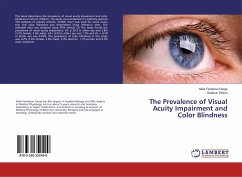
The Centrifugal Visual System of Rat
Versandkostenfrei!
Versandfertig in 6-10 Tagen
32,99 €
inkl. MwSt.

PAYBACK Punkte
16 °P sammeln!
The sensory organs transmit the stimuli of theoutside world towards the central nervous system.Pathways exist in the opposite direction: from thecentral nervous system towards the sensory organs(centrifugal or retinopetal fibers). In bird andlower vertebrates the origin of the retinopetalfibers is well described now, but in mammals data onthe existence and the origin of the retinopetalfibers are contradictory. In our present work we have provided direct evidencefor a novel retinopetal pathway in rat between thelimbic structures and the retina. We call thisdistinct pathway as limboretinal one. ...
The sensory organs transmit the stimuli of the
outside world towards the central nervous system.
Pathways exist in the opposite direction: from the
central nervous system towards the sensory organs
(centrifugal or retinopetal fibers). In bird and
lower vertebrates the origin of the retinopetal
fibers is well described now, but in mammals data on
the existence and the origin of the retinopetal
fibers are contradictory.
In our present work we have provided direct evidence
for a novel retinopetal pathway in rat between the
limbic structures and the retina. We call this
distinct pathway as limboretinal one. Intravitreous
injection of retrograde tracer labeled cells in
several limbic structures: the hippocampus, dentate
gyrus, the indusium griseum, the olfactory tubercle,
and the medial habenula, and in hypothalamic
magnocellular nuclei. Their number was 1495±516. Some
of the retrograde labeled cells were also labeled
with VIP,PACAP or LHRH. Iontophoretic application of
an anterograde tracer into the hippocampal formation
resulted in labeled fibers in the optic nerve and in
the retina.
We suggest to use this book to all researchers who
deal with the visual system of vertebrates.
outside world towards the central nervous system.
Pathways exist in the opposite direction: from the
central nervous system towards the sensory organs
(centrifugal or retinopetal fibers). In bird and
lower vertebrates the origin of the retinopetal
fibers is well described now, but in mammals data on
the existence and the origin of the retinopetal
fibers are contradictory.
In our present work we have provided direct evidence
for a novel retinopetal pathway in rat between the
limbic structures and the retina. We call this
distinct pathway as limboretinal one. Intravitreous
injection of retrograde tracer labeled cells in
several limbic structures: the hippocampus, dentate
gyrus, the indusium griseum, the olfactory tubercle,
and the medial habenula, and in hypothalamic
magnocellular nuclei. Their number was 1495±516. Some
of the retrograde labeled cells were also labeled
with VIP,PACAP or LHRH. Iontophoretic application of
an anterograde tracer into the hippocampal formation
resulted in labeled fibers in the optic nerve and in
the retina.
We suggest to use this book to all researchers who
deal with the visual system of vertebrates.












